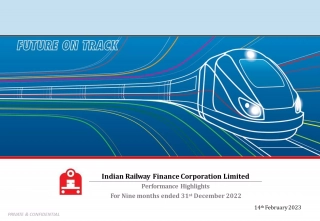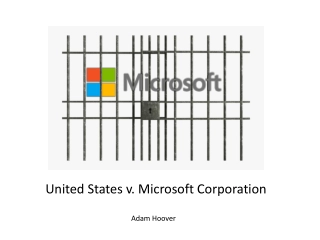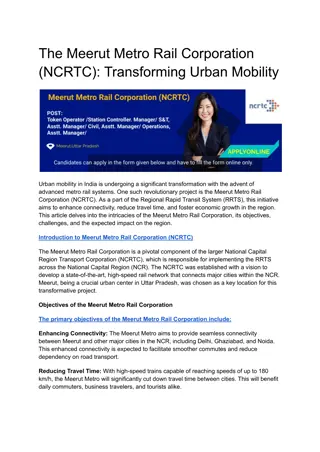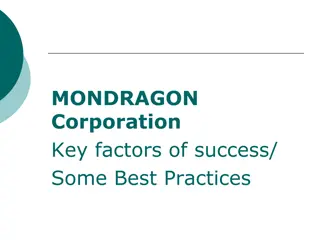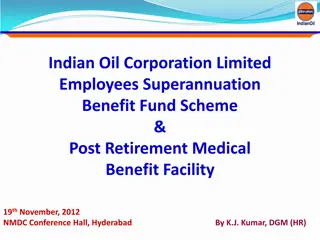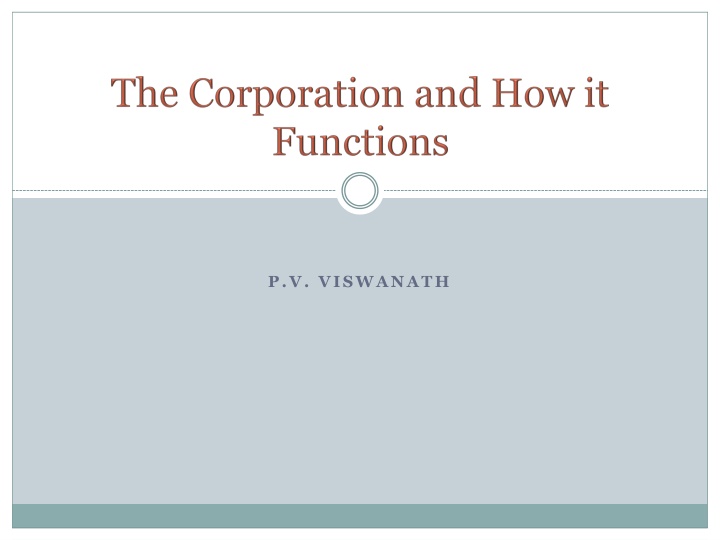
Corporate Governance Structures and Firm Types
Explore the concept of corporate governance, its relevance, different firm structures, the objectives of a firm, fiduciary obligations to shareholders, and ways to resolve principal-agent problems within corporations. Delve into traditional and alternative views of corporate governance to gain a comprehensive understanding.
Download Presentation

Please find below an Image/Link to download the presentation.
The content on the website is provided AS IS for your information and personal use only. It may not be sold, licensed, or shared on other websites without obtaining consent from the author. If you encounter any issues during the download, it is possible that the publisher has removed the file from their server.
You are allowed to download the files provided on this website for personal or commercial use, subject to the condition that they are used lawfully. All files are the property of their respective owners.
The content on the website is provided AS IS for your information and personal use only. It may not be sold, licensed, or shared on other websites without obtaining consent from the author.
E N D
Presentation Transcript
2 What is corporate governance? Why is it relevant? Different kinds of firm structures What s a corporation and who owns it What is the ex ante objective of the firm? What is the ex-post objective of the firm? Why should the firm s board have a fiduciary obligation to shareholders? How is the principal-agent problem between the managers and the shareholders resolved? What is the traditional view of corporate governance? What is Prof. Colin Myers alternative view of corporations?
3 Every decision that a business makes has financial implications, and any decision which affects the finances of a business is a corporate finance decision. Defined broadly, everything that a business does fits under the rubric of corporate finance. A business firm can be structured in several different ways, only one of which is the corporation. In this set of slides, we will discuss the governance structure of the corporation and try to understand the conceptual basis behind it. P.V. Viswanath
4 In a corporation, there is always more than one stakeholder; hence, we need a resolution mechanism to resolve conflicts of interest. Corporate Governance is the entirety of a corporation s organization and structure as well as the contracts, implied and explicit, between the firm and its stakeholders. This is important because the governance structure of a corporation determines its direction and performance, as we shall see. We will see that there it is possible to discern a rational arrangement behind corporate governance structures in the US. Our discussion will also allow us to critique such structures, whether in the US or elsewhere.
5 We first discuss the legal structures of non-corporate firms in the US, before discussing corporations. Sole Proprietorships A business owned and run by one person. 71% of businesses in 2007 were sole proprietorships, but they accounted for only 5% of total sales. Easy to set up. The owner has unlimited personal liability. Partnerships Like a sole proprietorship, but with more than one owner. All partners are liable for the firm s debt. Law firms, groups of doctors are often organized as partnerships. The partner s personal liability increases the confidence of the firm s clients that the partners will work to maintain the firm s reputation. http://www.bizstats.com/reports/industry-sales-firm-summary.asp P.V. Viswanath
6 Limited Partnership Has general partners, who have unlimited liability; and limited partners with liability limited to the extent of their investment. The general partner runs the business; limited partners cannot be legally involved in business decisions. Limited Liability Company (LLC) Similar to a limited partnership, but without a general partner; all partners can run the business. The LLC is a separate legal entity. Allows pass-through taxation. S-Corporation (intermediate betw. an LLC and a corporation) Allows pass-through taxation Limited in the number of shareholders that it can have. Can have a perpetual life, in contrast to an LLC. Stock is freely transferable, in contrast an LLC, where the consent of other partners is required. P.V. Viswanath
7 A corporation (also called a C-corporation, in contrast to an S-corporation) is similar to an LLC, and is a legally defined entity, separate from its owners. It can enter into contracts, acquire assets and incur obligations. The owners of a corporation are not liable for its obligations and it is not liable for any personal obligations of its owners. Corporations must be legally formed according to the laws of the state where it is incorporated. The corporate charter specifies the rules by which the corporation is run. P.V. Viswanath
8 The entire ownership stake of a corporation is divided into shares known as stock. The collection of all the outstanding shares of a corporation is known as its equity. An owner of a corporation is known as a shareholder and is entitled to dividend payments, made at the discretion of the corporation. The management of a corporation is different from its ownership; this allows free trade in its shares. This means that a corporation can raise more funds than a partnership or a sole proprietorship. Since the corporation is a separate entity, it is taxed on its profits; its shareholders are taxed again on their dividends. This is in contrast to an S-corporation. P.V. Viswanath
9 Who is the owner of a corporation? Shareholders Managers Bondholders Employees Government None of the above All of the above
10 Since there are usually shareholders of a corporation, it is not feasible for all of them to have a direct say in management. Hence shareholders exercise control by electing a board of directors, who have ultimate decision-making authority. The board delegates most day-to-day decisions to management, which is headed by the chief executive officer (CEO). The CEO is charged with running the corporation according to the rules and policies set by the Board. Sometimes the CEO is also the chairman of the Board. P.V. Viswanath
11 Even though we have referred to shareholders as owners, what they own are rights to a stream of cashflows from the corporation that constitute a residual after payment to other claimholders. They are not directly owners of the assets and, as explained above, they do not control the disposition of assets as an owner of real assets would. They only have indirect control over the actions of the corporation. Consequently, it is better to think of them as holders of claims to residual cashflows with special characteristics rather than as owners. This will help in understanding their role in corporate governance.
12 One occasion when the question of ownership of a corporation comes into play is when it becomes bankrupt, which essentially means that it is not able to pay its debts. In such a situation, the creditors are entitled to seize its assets in compensation for the default. To prevent this, the management may negotiate with creditors or may file in court for bankruptcy protection. In bankruptcy, management is given the chance to reorganize the firm and negotiate with creditors without fear of assets being seized. This allows for an orderly liquidation (Chapter 7) or for an orderly transfer of control to creditors (Chapter 11). When a firm emerges from bankruptcy, existing shareholders may maintain control but their stake is greatly reduced. P.V. Viswanath
13 When a firm operates under bankruptcy, the managers are supposed to run the firm for the benefit of the corporation, which may not be the same as the interests of shareholders. For example, in Ford Motor Credit Co. v. Weaver (1982), the court held that the board s duty is to protect and maximize the return to the estate s assets, not to waste assets by continuing to operate or incurring additional debt if there is no reasonable chance for reorganization; such a strategy is more likely to benefit creditors than shareholders. This is an example of how shareholding is not quite the same as ownership.
14 A bankrupt company Has no assets Has to be liquidated Has a share price of zero Does not have a worthwhile business model Cannot meet its payment obligations to creditors May be able to exit bankruptcy by renegotiating with its creditors
15 From an outsider s perspective, one of the most important aspects of an investment in a corporation is its liquidity, i.e. the ability to convert it into cash with very little loss. This is possible because the shares of many corporations are traded on organized exchanges. Such corporations are called public companies or publicly listed companies. The largest exchanges in the US are the NYSE, the AMEX and the Nasdaq. All US exchanges operate through electronic trading. However, there are some differences. The NYSE and the AMEX have specialists/Designated Market Makers who have responsibility to ensure a liquid and orderly market. On the Nasdaq, there are market makers who post bids and offers to trade in shares at different prices; the system is set up to fill orders at the best prices. What liquidity implies, though, is that the set of shareholders can be constantly changing! P.V. Viswanath
16 The objective of the firm, has been traditionally understood by economists as the maximization of total firm value. This is defined as the sum of all the values that accrue to all participants in the firm stockholders, bondholders, managers, employees, and all other stakeholders in the firm including society. Society must also be recognized as a stakeholder because the firm operates within a social and legal framework, which adds value by providing the firm with a structured environment. Why? The larger the value of the firm, the larger the potential gains to all participants in the firm. It is logical to assume that this is the goal of the different parties that get together to make up the firm before it is organized. The choice of organizational structures is also made by trying to maximize firm value. P.V. Viswanath
17 Stock Markets: Allow investors to enter and exit their equity investments easily Aggregate information about the value of a firm Allow diversified ownership of a business Allow the founders of a business to reduce their stake in the firm Facilitate hostile takeovers Facilitate speculation based on rumors Allow small shareholders to exert power jointly against management
19 Ultimately, since management runs the firm, it is important to make sure that they have the right incentives. However, manager actions are not fully observable. If managers do not work to maximize firm value, no one group of stakeholders has a strong incentive to monitor management and take corrective steps. Bondholders may not act because there is only a weak connection between firm value and bond value. Stockholders may not act because bondholders will also benefit, without having to absorb any of the costs of monitoring management. Employees are not directly benefited by maximization of firm value. P.V. Viswanath
20 Hence it may be necessary to set up an ex-post objective that favors a single group, who will then have a stronger incentive to monitor managers. The establishment of a fiduciary duty of managers towards stockholders (rather than the entire firm) provides them with an incentive to monitor managers. Furthermore, stockholders are residual claimants. Hence by setting up maximization of stockholder wealth as an ex-post objective, we can get as close as possible to the ultimate goal of firm value maximization. Nevertheless, we still want to ensure that stockholder value maximization doesn t reduce firm value. P.V. Viswanath
21 Stockholders are called residual claimants because: Stockholders get all the value that s left over (residue) after making payments to other claimants (bondholders, employees, government) They are the most important of all claimants to the value generated by the operations of the firm. They control what other claimants can get.
22 The interests of managers, stockholders, bondholders and society can diverge. Managers may have other interests such as job security that they put over stockholder wealth maximization. Actions that make stockholders better off (increasing dividends, investing in risky projects) may make bondholders worse off. Actions that increase stock price may not necessarily increase stockholder wealth, if markets are not efficient or information is imperfect. Actions that makes firms better off may create such large social costs that they make society worse off. Agency costs refer to the explicit costs and implicit costs of suboptimal outcomes due to the conflicts of interest that arise between all of these different groups. A key part of corporate governance is to design a set of controls, regulations and incentives to minimize agency costs. P.V. Viswanath
23 In a principal-agent situation, there are two parties the principal and the agent. Which statement is true? The principal is the most important because s/he is the one who makes decisions and acts The agent is the party that makes the decisions and acts Sometimes the agent acts and sometimes the principal
24 Let s look at a few ways in which managers are controlled by the corporate governance system and incentivized to maximize shareholder value. Incentive Mechanisms Annual Meeting Board of Directors Market for Corporate Control
25 In order to align managers incentives with those of shareholders, managerial compensation is often tied to shareholder welfare. Managers may be given stock that they are not allowed to sell. However, this is expensive. Managers may be given stock options; these are less expensive, but they may give managers an incentive to take risky projects. These mechanisms also increase managers risk because they are exposed to share price fluctuation induced by factors not under their control, as well. One example of managers putting their interests first may be the tendency to overpay in takeovers. P.V. Viswanath
26 Board members received $350,000 in compensation and stock options annually, which was significantly above the norm, (U.S. Senate Subcommittee 2002, p.56). Compensation to Enron executives in 2001 was extraordinarily generous too, as shown by the following chart (Pacelle 2002), which includes the value of exercised stock options and excludes compensation from the partnerships: Kenneth Lay (Enron Chairman/CEO)...........................$152.7 (in millions) Mark Fevert (Chair and CEO, Enron Wholesale Services)....$31.9 Jeffrey Skilling (Enron CEO).......................................$34.8 J. Clifford Baxter (Enron Vice-Chairman).......................$16.2 Andrew Fastow (Enron CFO)......................................$4.2
27 Enron was a manifestation of the principal-agent problem high-powered incentive contracts provided management with incentives for self-dealing, significant costs were transferred to shareholders due to the obscurity in Enron s financial reporting, and due to the lack of board independence it is likely that management rent extraction occurred Peter Munzig, Enron and the Economics of Corporate Governance, https://citeseerx.ist.psu.edu/viewdoc/download?doi=10.1.1.198.104 3&rep=rep1&type=pdf
28 Stockholders of acquiring firms do not seem to share the enthusiasm of the managers in these firms. Stock prices of bidding firms decline on the takeover announcements a significant proportion of the time. Many mergers do not work, as evidenced by a number of measures. The profitability of merged firms relative to their peer groups, does not increase significantly after mergers. An even more damning indictment is that a large number of mergers are reversed within a few years, which is a clear admission that the acquisitions did not work. Managers may look to mergers to increase the size of assets under their control. Larger firms are more stable and may reduce managerial risk. P.V. Viswanath
29 Managers engage in mergers Because they want to control more assets Because a large firm is more stable and less likely to go bankrupt causing them to lose their jobs Only when it increases the value of the stock price Only when it increases the value of the firm
30 Other stockholder mechanisms for controlling management are the annual meeting and the board of directors. The power of stockholders to act at annual meetings is diluted by three factors Most small stockholders do not go to meetings because the cost of going to the meeting exceeds the value of their holdings. Incumbent management starts off with a clear advantage when it comes to the exercising of proxies. Proxies that are not voted becomes votes for incumbent management. For large stockholders, the path of least resistance, when confronted by managers that they do not like, is to vote with their feet, i.e. to sell their shares. P.V. Viswanath
31 The CEO often controls the composition/actions of the Board; this is likely if the CEO is also the Chairman of the Board. Directors serve on boards of many companies they don t the time or focus. Directors lack the expertise to ask the necessary tough questions.. The CEO sets the agenda, chairs the meeting and controls the information. The search for consensus overwhelms any attempts at confrontation. P.V. Viswanath
32 No stockholder approval needed .. Stockholder Approval needed Takeovers are also a means of disciplining managers. However, managers often try to subvert takeover attempts in various ways. Some of these are: Greenmail: The (managers of ) the target of a hostile takeover buy out the potential acquirer's existing stake, at a price much greater than the price paid by the raider, in return for the signing of a 'standstill' agreement. Golden Parachutes: Provisions in employment contracts, that allows for the payment of a lump-sum or cash flows over a period, if managers covered by these contracts lose their jobs in a takeover. Poison Pills: A security, the rights or cashflows on which are triggered by an outside event, generally a hostile takeover, is called a poison pill. Shark Repellents: Anti-takeover amendments are also aimed at dissuading hostile takeovers, but differ on one very important count. They require the assent of stockholders to be instituted. P.V. Viswanath
33 However, hostile takeovers often do work. The typical target firm in a hostile takeover has a return on equity almost 5% lower than its peer group had a stock that has significantly under performed the peer group over the previous 2 years has managers who hold little or no stock in the firm In other words, the best defense against a hostile takeover is to run your firm well and earn good returns for your stockholders Conversely, when you do not allow hostile takeovers, it is the firm that you are most likely protecting (and not a well run or well managed firm) P.V. Viswanath
34 Even with all these incentives, there is evidence that managers suppress information, generally negative information delay the releasing of bad news bad earnings reports other news sometimes reveal fraudulent information In October 1995, a Canadian company, Bre-X Minerals Ltd., reported that significant amounts of gold had been discovered in an Indonesian site that it owned, sending its stock price soaring. Originally a penny stock, its stock price reached a peak at C$286.50 (split adjusted) in May 1996. Bre-X Minerals collapsed in 1997 after the gold samples were found to be a fraud. How does the financial system deal with this? P.V. Viswanath
35 One answer is that financial analysts discipline managers. While analysts are more likely still to issue buy rather than sell recommendations, the payoff to uncovering negative news about a firm is large enough that such news is eagerly sought and quickly revealed (at least to a limited group of investors) As information sources to the average investor proliferate, it is becoming much more difficult for firms to control when and how information gets out to markets. As option trading has become more common, it has become much easier to trade on bad news. In the process, it is revealed to the rest of the market. When firms mislead markets, the punishment is not only quick but it is savage. Nevertheless, there are still problems with financial markets as a control on managerial actions. P.V. Viswanath
36 Prices are much more volatile than justified by the underlying fundamentals E.g. Did the true value of equities really decline by 20% on October 19, 1987? Financial markets overreact to news, both good and bad Financial markets are short-sighted, and do not consider the long-term implications of actions taken by the firm E.g. the focus on next quarter's earnings Financial markets are manipulated by insiders; Prices do not have any relationship to value. Overall, markets do react in expected ways to economic decisions taken by firms P.V. Viswanath
37 Type of Announcement Abnormal Returns on Announcement Day Announcement Month Joint Venture Formations 1.412% 0.399% R&D Expenditures 1.456% 0.251% Product Strategies -0.35% 0.440% Capital Expenditures 1.499% 0.290% All Announcements 0.984% 0.355% P.V. Viswanath
38 Corporate decisions can also create social costs and benefits. A social cost or benefit is a cost or benefit that accrues to society as a whole and not to the firm making the decision. Here are examples of social costs: Environmental costs (pollution, health costs, etc.) Quality of Life' costs (traffic, housing, safety, etc.) Examples of social benefits include: Creating employment in areas with high unemployment Supporting development in inner cities Creating access to goods in areas where such access does not exist However, if shareholders do not benefit from socially beneficial actions firms may not take enough of these; similarly, they make engage in actions that are socially detrimental but that do not hurt shareholders. P.V. Viswanath
39 Market prices of shares are attacked as not reflecting true underlying value because: Prices are much more volatile than justified by the underlying fundamentals Financial markets often overreact to news They do not take bondholder wealth into account They do not take long-term implications of managerial actions into account They can be manipulated by insiders They can be swayed by uninformed trading They increase wealth inequality in society
40 If firms consistently flout societal norms and create large social costs, the governmental response (especially in a democracy) is for laws and regulations to be passed against such behavior. e.g.: Laws against using underage labor in the United States Sarbanes-Oxley For firms catering to a more socially conscious clientele, the failure to meet societal norms (even if it is legal) can lead to loss of business and value e.g. Specialty retailers being criticized for using under age labor in other countries (where it might be legal) Finally, investors may choose not to invest in stocks of firms that they view as social outcasts. e.g.. Tobacco firms and the growth of socially responsible funds (Calvert..) P.V. Viswanath
41 Although there are misalignments between manager interests and stockholder interests, there are many mechanisms, such as Managerial compensation Takeovers Board of Directors Annual General Meeting These work most of the time. When they don t financial analysts act as disciplinarians. Firms may also work against the interests of bondholders; contractual methods are used to mitigate such actions. But firms may also work against the interests of society. In such cases, society may have to take steps through legislation and regulation. P.V. Viswanath
42 The previous narrative conditioned the shareholder value optimization narrative on empirical evidence that it had the best chance of maximizing societal value. However, there is accumulating evidence that this narrative may not be supported by new data. Some of the contrary evidence points to: Inefficiency of capital markets Waste of resources by capital market investors playing in a winner-take- all system Inequality of wealth leading to inequality of political access Inability of markets/contracts to solve agency problems between stockholders and bondholders and between stockholders and the firm. This has led to proposals to modify the way the law treats corporations. Prof. Colin Mayer has some suggestions in four different areas. https://millstein.law.columbia.edu/news/colin-mayers-prosperity-and-future-corporation
43 Currently, corporation laws are focused on protecting shareholder rights, and boards fiduciary duties are centered around serving the best interests of shareholders. Instead, laws should require companies to define and deliver on their corporate purposes. Regulations now create and enforce the rules of the game in the traditional context of the Friedman doctrine. Rather, they should instead seek to align corporate purposes with public purposes in those companies in which it is appropriate to do so (e.g., banks and audit companies, utility providers, and infrastructure companies). Public Interest Entities in the EU are an example. These are undertakings of significant public relevance because of the nature of their business, their size or the number of their employees.
44 Corporate ownership currently centers around shareholders (especially institutional shareholders) and their robust bundle of property rights. Rather, corporate ownership should also be viewed more broadly as an obligation and responsibility to uphold corporate purposes. We should recognize that there are many different types of owners that are best suited to perform that function in different circumstances (including families, foundations, employees, the state, and institutional investors). Modern governance is preoccupied with solving agency problems and aligning managerial interests with shareholder interests; instead, it should align the interests of management with corporate purposes.
45 Firms performance is measured by financial performance and accounts for the use of financial and material capital. But other forms of capital specifically, human, natural, and social capital have become scarcer and more important in the 21st century. Hence, profits and performance should be measured net of the cost of maintaining these capitals. Explicit payments by the firm to compensate for use of these kinds of capitals is one solution. However, development of alternate metrics is also a solution that should be considered.
46 Finance is generally viewed as a set of contractual arrangements (rather than relationships) between suppliers and users of finance. Instead, we must recognize that in order to align the private interests of companies and financial institutions with their social purposes, relationships between firms and finance providers are important both in the context of debt finance (primarily, banking relationships) and in terms of shareholder relations. Better resolution of agency problems between the firm and shareholders often requires the presence of block equity holders with whom relationships can be developed.
47 Public policy should not favor one form of finance over another, and distortions such as the deductibility of interest payments on corporate borrowing should be eliminated. Private capital markets alone are often not able to provide the types of financing companies need (for instance, in the case of large, long-term infrastructure projects). In these cases, strong relations of trust between government and business are especially important, and it is critical to align the private interests of companies with the public interest by, for example, the adoption of their public licensing requirements into their articles of association or charters.
48 B Corporation (also B Lab or B Corp) certification of "social and environmental performance" is a private certification of for-profit companies. B Corp certification is conferred by B Lab, a global nonprofit organization with offices in the United States, Europe, Canada, Australia and New Zealand, and a partnership in Latin America with Sistema B. To be granted and to maintain certification, companies must receive a minimum score from an assessment of "social and environmental performance", integrate B Corp commitments to stakeholders into company governing documents, and pay an annual fee based on annual sales. From Wikipedia

